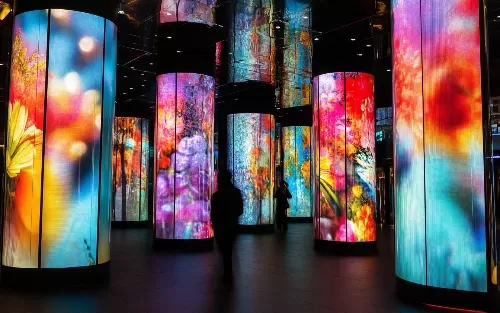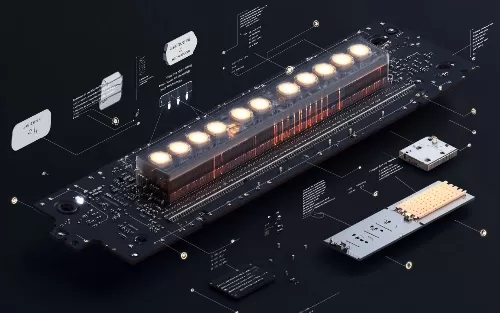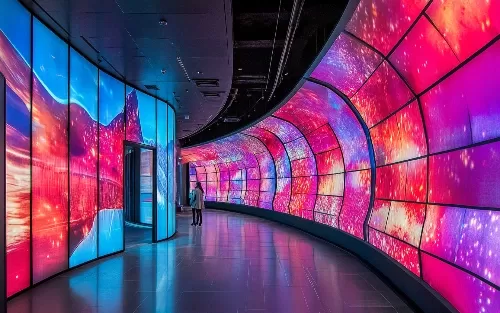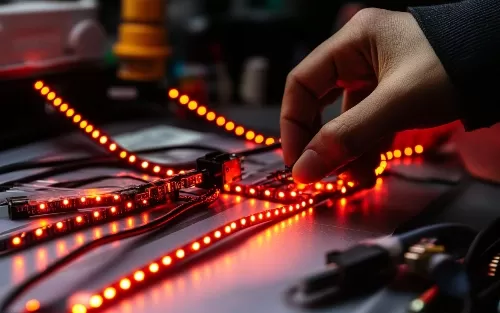Flexible LED modules are revolutionizing the way we light up our spaces. These versatile lighting solutions offer endless design possibilities, making them perfect for both commercial and residential use. With their sleek, slim profiles, they can fit into tight spots and adapt to various shapes and surfaces.
Whether you're enhancing ambiance or creating eye-catching displays, flexible LED modules deliver bright, energy-efficient illumination. They are easy to install and can be customized to meet your specific needs. Dive into the world of flexible LED modules and discover how they can transform your environment while saving on energy costs.
Flexible LED modules are versatile lighting solutions that can be customized for various applications, making them ideal for creative designs in different industries.
Key benefits include energy efficiency and long lifespan, which can significantly reduce operational costs for businesses and enhance sustainability efforts.
These modules can be used in a wide range of settings, from architectural lighting to advertising displays, demonstrating their adaptability to meet diverse needs.
Understanding the technology behind flexible LED modules is crucial; they often use advanced materials that allow for bending and shaping without compromising performance.
Proper installation and maintenance are vital for maximizing the lifespan and effectiveness of flexible LED modules—follow the provided guidelines to ensure optimal usage.
Adopting best practices when using these modules will enhance their performance and reliability, helping you achieve your lighting goals efficiently.
Flexible LED modules are advanced lighting solutions. They consist of small LED lights mounted on a flexible substrate. This allows them to bend and conform to various surfaces. Their significance lies in their ability to create customized displays that traditional rigid panels cannot achieve.
These soft LED modules offer incredible versatility. They can be used in numerous shapes and configurations. Designers can easily shape them into curves, circles, or even complex designs. This flexibility opens up new possibilities for creative projects.
For example, businesses use flexible LED panels in advertising displays. They can wrap around columns or fit into unusual spaces. This adaptability makes them ideal for unique architectural features.
The popularity of flexible LED modules is rising rapidly. Many industries are adopting these technologies for both indoor and outdoor settings. Retail stores use them to enhance visual merchandising. Museums and galleries incorporate them for artistic installations.
Outdoor events benefit from flexible LED modules too. They provide vibrant displays that attract attention. Events like concerts and festivals often feature these adaptable lights.
Flexible modules also have practical applications in transportation. Buses and trains use them for dynamic signage. They can display real-time information in an eye-catching way.
In summary, the increasing demand for customizable solutions drives the growth of flexible LED technology. As more people recognize their benefits, usage will likely expand further.
Flexible LED modules offer high refresh rates, typically at 1920Hz or 3840Hz. These rates ensure smooth video playback and reduce flicker. This feature is crucial for applications like live events and broadcasts. Viewers enjoy a clear, vibrant visual experience. The high refresh rate enhances the overall display quality, making it suitable for various environments.
Replacement of flexible LED modules is straightforward. Users can easily swap out faulty panels without much hassle. Many designs include front service options. This accessibility saves time and effort during maintenance. It allows users to focus on their projects rather than technical difficulties.
A wide range of pixel options exists for flexible LED modules. Providers offer different pixel pitches to fit various project needs. Smaller pixel pitches provide higher resolution displays. Larger pitches may be more suitable for outdoor settings where viewing distance is greater.
Panel sizes also vary significantly. This flexibility allows users to choose the best size for their specific requirements. Whether it's a small installation or a large-scale event, there’s a solution available.
Different types of flexible LED modules cater to diverse applications. Some are designed for indoor use, providing excellent color accuracy and brightness. Others are made for outdoor settings, featuring weather-resistant materials.
Folding capabilities enhance versatility. Users can shape these modules into various forms, such as curves or angles. This adaptability allows for unique designs in advertising displays or stage setups.
Providers focus on meeting customer needs with customizable solutions. They understand that each project has its own specifications and challenges. Thus, they offer complete sets tailored to individual requirements.
This approach ensures that clients receive products that align with their goals. Flexibility in design and functionality helps businesses stand out in competitive markets.
The integration of flexible LED modules improves the viewer experience significantly. Brightness and clarity draw attention to ads or content displayed on the screen. Engaging visuals capture interest quickly.
Thanks to advancements in technology, these modules have become essential in many industries. They enhance not just aesthetics but also functionality in advertising and entertainment sectors.

Flexible LED modules play a crucial role in the retail sector. Stores use these modules to create eye-catching displays. They can form curved LED walls that attract customers. These walls enhance the shopping experience with vibrant colors and dynamic content. Retailers often utilize this technology for product promotions and brand storytelling.
Many stores also employ flexible LED modules for unique signage solutions. These signs can easily fit into any space, no matter the shape. This adaptability allows retailers to stand out in crowded markets.
The events industry benefits significantly from flexible LED technology. Event organizers use these modules for various displays. Concerts, trade shows, and exhibitions feature customized LED backdrops made from flexible modules. These backdrops can be shaped to match specific themes or branding.
Flexible LED modules offer versatility in design. They allow event planners to create immersive environments. Attendees enjoy engaging visuals that enhance their overall experience.
Artists and designers embrace flexible LED modules for creative projects. They use these modules to develop unique installations. The flexibility of the modules allows artists to experiment with shapes and sizes.
Art exhibits often showcase innovative uses of flexible LED technology. Artists can create moving images or interactive displays that captivate audiences. This technology provides endless possibilities for artistic expression.
Businesses across various sectors adopt flexible LED modules for commercial purposes. Restaurants use them for menu displays that change throughout the day. Hotels incorporate them into lobbies for welcoming messages and promotions.
These modules are not just functional; they also enhance aesthetics. Businesses can customize colors and designs to align with their brand identity. This adaptability helps companies communicate effectively with customers.
SMD components play a crucial role in flexible LED modules. These components include surface-mounted devices that enhance image quality and refresh rates. They allow for better light emission and color accuracy. The use of high-quality SMDs can significantly improve the overall performance of the display.
Higher refresh rates are vital for dynamic content. They reduce motion blur, making images appear smoother. This is particularly important in applications like video walls and digital signage. Enhanced image quality attracts viewers and keeps their attention.
High-quality driving ICs are essential for achieving color uniformity in flexible LED modules. These integrated circuits control how each LED emits light. They ensure consistent brightness across the entire display surface. Without reliable driving ICs, colors may appear uneven or distorted.
Driving ICs also affect the module's lifespan. Poor quality can lead to flickering or failure over time. Investing in superior driving ICs enhances both performance and longevity. This investment pays off in terms of reduced maintenance costs.
Pixel pitch is a key concept in understanding display resolution. It refers to the distance between the centers of two adjacent pixels. Smaller pixel pitches result in higher resolution displays. This means more detail can be shown, which is critical for close-viewing applications.
For instance, a pixel pitch of 1.5mm offers sharp images for indoor settings. In contrast, a larger pitch, like 10mm, suits outdoor displays viewed from a distance. Choosing the right pixel pitch depends on the intended use and viewing distance.
Understanding pixel pitch helps users select the best display for their needs. A well-chosen pitch maximizes visual impact and effectiveness.

Flexible LED modules operate by using light-emitting diodes (LEDs) arranged on a flexible substrate. These LEDs emit light when an electric current passes through them. Each module consists of multiple small LEDs that can produce various colors. This allows for vibrant displays and smooth transitions in images or videos.
The flexibility of these modules means they can be bent or shaped into different forms. This feature makes them ideal for creative installations, such as curved screens or intricate designs. The technology behind flexible LED modules allows for high-resolution video shows. Users can create captivating visuals that grab attention in any environment.
Magnetic installation is a key feature of flexible LED modules. Magnets are embedded in the back of each module, allowing for quick setup and adjustments. This design eliminates the need for complicated mounting systems. Installers can easily attach and detach modules without tools.
This magnetic system also promotes efficiency during events or exhibitions. If a display needs to change shape or size, it can be done swiftly. For example, if a company wants to showcase different products, they can rearrange the modules in minutes. This adaptability saves time and enhances creativity in display design.
Connecting multiple flexible LED modules creates larger displays. Each module has connectors that link with adjacent units. These connectors allow for seamless integration between modules. Users can build expansive screens suited for concerts, trade shows, or advertising.
To connect the modules, follow these steps:
1) Align the edges of the modules.
2) Securely attach the connectors.
3) Power up the connected display.
4) Adjust settings as needed.
This process ensures that the entire display works together as one cohesive unit. It enables users to create stunning visuals across large areas.
Flexible LED modules are becoming popular in various settings. They are used in shopping malls, stadiums, and events worldwide. Their capability to create dynamic video shows attracts audiences and enhances experiences.
In summary, flexible LED modules work through advanced technology that combines flexibility with easy installation and connectivity options. Their operational principles allow for engaging displays, while magnetic installation simplifies setup. Connecting multiple modules offers endless possibilities for larger displays.

Flexible LED modules open up new design possibilities. They allow for unique configurations that traditional screens cannot achieve. Designers can create displays that bend and curve to fit various spaces. This flexibility is crucial for environments like retail and exhibitions. Brands use these modules to attract attention in crowded areas. The ability to customize shapes enhances advertising efforts significantly.
Creating seamless surfaces is another advantage of flexible LED technology. These modules can connect without visible seams, providing a smooth visual experience. This feature is vital for immersive installations, where the viewer's attention should not be distracted by gaps. For instance, museums and art galleries benefit from this design. They can create stunning visuals that pull viewers into the experience. Using flexible modules, designers can transform walls into dynamic art pieces.
Trends show an increasing demand for custom shapes in display technology. Flexible LED modules cater to this need perfectly. Designers can craft unique forms tailored to specific requirements. For example, curved or circular displays are becoming popular in events and promotions. Brands want to stand out with eye-catching designs that convey their message effectively.
Special customization options further enhance the appeal of flexible LED modules. Manufacturers offer a range of colors, brightness levels, and pixel pitches. This variety allows companies to match their branding precisely. Some brands choose bright colors for high visibility, while others prefer softer tones for a more subtle look. The flexibility in customization makes these modules suitable for various applications.
Screen wall optional cabinet solutions provide practical advantages as well. These cabinets support easy installation and maintenance of flexible LED modules. Users can quickly replace individual panels without dismantling the entire setup. This feature saves time and reduces costs during repairs or updates.
The impact of flexible LED technology is forceful in today's market. It transforms how businesses advertise and engage with customers. From retail displays to event stages, the applications are vast. Companies leverage this technology to create memorable experiences that drive customer interaction.

Proper tools ensure a smooth installation. Essential tools include:
Screwdriver
Drill
Level
Measuring tape
Wire cutters
Soldering iron (if needed)
These tools help in mounting the screen module securely.
Start by planning the installation. Measure the area where you will install the flexible LED module. Mark the points where you will mount it. Check for any obstacles that could interfere with the installation.
Next, gather all necessary materials. This includes the flexible LED modules, power supply, and connectors. Ensure everything is compatible with your screen module.
Begin by securing the mounting brackets to the wall or structure. Use a level to ensure they are straight. Then, attach the flexible LED module to these brackets. This step requires careful alignment. Misalignment can lead to uneven lighting.
Once aligned, secure the module using screws or clips provided by the manufacturer. Check that each section of the module connects properly.
After mounting, focus on wiring. Connect the power supply to the flexible LED module. Follow the manufacturer's instructions carefully. Ensure all connections are tight to avoid flickering lights.
If soldering is necessary, use a soldering iron to connect wires properly. Make sure to insulate any exposed wires with electrical tape for safety.
Once everything is connected, turn on the power supply. Test each section of the flexible LED module to ensure they light up correctly. If some parts do not work, check connections again.
If any sections appear dim or flicker, adjust their alignment slightly. Sometimes small tweaks can make a big difference in performance.
Consider adding a controller if you want more features like dimming or color changes. This addition enhances flexibility and usability.
1) Always double-check measurements before cutting.
2) Use a level frequently during installation.
3) Work in a well-lit area for better visibility.
4) Keep extra connectors and tools handy in case of issues.
5) Consult manuals for specific installation details related to your product.
Following these steps ensures a successful installation of your flexible LED module. Proper alignment and secure mounting are crucial for optimal performance.
Routine checks are essential for flexible LED modules. Regular inspections help identify issues before they worsen. Check connections and wiring monthly. Look for any signs of wear or damage. Ensure the modules are securely mounted to avoid movement that can cause damage.
Inspect the brightness levels as well. Uneven lighting may indicate a problem with the module or power supply. Perform these checks every month to maintain optimal performance.
Cleaning is crucial to preserve the quality of the LED surface. Dust and dirt can accumulate over time, affecting visibility. Use a soft microfiber cloth for cleaning. This prevents scratches on the LED surface.
For deeper cleaning, use a mild soap solution mixed with water. Dampen the cloth with this solution and gently wipe the surface. Avoid using harsh chemicals or abrasive materials, as they can damage the LEDs. Always ensure the module is powered off before cleaning.
Common issues can arise with flexible LED modules. One frequent problem is flickering lights. This often results from poor connections or a faulty power supply. Check all connections first, then test the power supply.
Another issue is color inconsistency across the screen. This can occur if some LEDs fail while others operate normally. Replacing faulty LEDs usually resolves this problem.
Overheating is also a concern. If a module becomes too hot, it may shut down to protect itself. Ensure adequate ventilation around the installation area to prevent overheating.
Troubleshooting techniques can help resolve issues quickly. Start by turning off the power and inspecting all wiring connections. Loose wires can lead to flickering or complete failure.
If problems persist, check the power supply voltage and current ratings against the specifications of your module. An incorrect power supply can lead to malfunction.
For color inconsistency, use diagnostic tools to identify which LEDs are malfunctioning. Replace them as needed to restore uniformity across the display.

Flexible LED modules work best in specific scenarios. They shine in environments with controlled lighting. For example, using them in dimly lit areas enhances visibility. Bright light can wash out the colors on the display.
Consider using these modules for advertising and artistic displays. They adapt well to various shapes and sizes. This flexibility allows for unique installations that attract attention. Ensure the content is high-quality to maximize display effectiveness.
Regular updates are crucial for optimal performance. Manufacturers often release firmware updates for flexible LED modules. These updates introduce new features and fix bugs. Keeping the software current ensures users benefit from the latest advancements.
Check for updates every few months. This practice keeps your display running smoothly and efficiently. Ignoring updates may lead to missed opportunities for enhanced functionality.
Environmental factors significantly affect display performance. Temperature fluctuations can impact how well the modules function. High humidity levels may also cause issues like condensation.
Install flexible LED modules in locations where conditions are stable. Avoid placing them near heat sources or in direct sunlight. Such environments can shorten the lifespan of the modules.
Awareness of these factors helps maintain display quality over time. Regular inspections can identify potential problems before they escalate.
Efficient power management is vital for flexible LED modules. Overloading circuits can lead to flickering or display failure. Always follow manufacturer guidelines regarding power requirements.
Consider investing in power management solutions if using multiple modules. These solutions help distribute power evenly and prevent overloads.
Proper installation techniques ensure long-term success with flexible LED modules. Secure mounting is essential to avoid sagging or misalignment. Use appropriate hardware based on the surface type.
Follow specific guidelines provided by manufacturers during installation. This step prevents damage and ensures optimal performance from the start.
Flexible LED modules are game-changers in lighting. They offer versatility, efficiency, and a stunning array of applications across various industries. You’ve learned about their key features, installation tips, and how to maintain them for optimal performance. This knowledge empowers you to make informed choices that enhance your projects.
Now it's time to take action. Explore flexible LED modules for your next project. Dive into the latest designs and innovations that can elevate your space. Whether you're revamping a retail environment or creating an immersive experience, these modules can transform your vision into reality. Don’t wait—your lighting revolution starts today!
Flexible LED modules are thin, bendable strips of LED lights designed for versatile applications. They can conform to various surfaces and shapes, making them ideal for creative lighting designs.
Typically, flexible LED modules have a lifespan of 30,000 to 50,000 hours. This longevity reduces the need for frequent replacements, saving time and costs.
Yes, most flexible LED modules can be easily cut at designated points. This feature allows for customization to fit specific design requirements.
Absolutely! Flexible LED modules consume significantly less energy compared to traditional lighting solutions. This efficiency leads to lower electricity bills and a smaller carbon footprint.
Flexible LED modules find application in various industries, including architecture, automotive, advertising, and entertainment. Their versatility makes them suitable for both indoor and outdoor settings.
Installation typically involves cleaning the surface, peeling off the adhesive backing, and sticking the module in place. Ensure proper power supply connections for optimal performance.
No special maintenance is needed. Regularly check for dirt or dust accumulation and clean gently with a soft cloth to maintain brightness and functionality.